
Полная версия:
The Allotment Chef: Home-grown Recipes and Seasonal Stories


Photograph by Mary-Jane Curtis
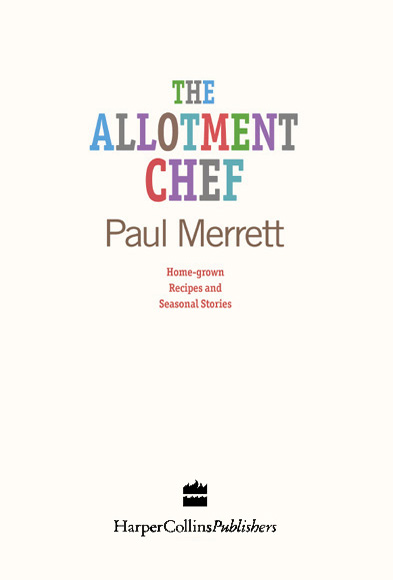
Dedication
For MJ, Ellie and Richie
Contents
Cover
Title Page
Dedication
CHAPTER 1 Crop Idle
CHAPTER 2 By Royal Appointment
CHAPTER 3 The Ealing Project
CHAPTER 4 Read What You Sow
CHAPTER 5 iPods and Asparagus
CHAPTER 6 Chuck Berry
CHAPTER 7 Freezing in August
CHAPTER 8 Gentlemen of the Committee
CHAPTER 9 My Children and Other Pests
CHAPTER 10 Happy Bloody Christmas
CHAPTER 11 Johnny Depp at the Allotment
CHAPTER 12 Do the Mashed Potato
CHAPTER 13 Frozen Vegetables
CHAPTER 14 A Load of Shit
CHAPTER 15 Sodden, Sodding, Sod
CHAPTER 16 Here Comes the Sun
CHAPTER 17 The End is Nigh
RECIPES
Soups, Starters and Salads
Creamy Potato and Parsley Soup
Hot and Chilled Tomato Soup
French Onion Soup
Asparagus Soup
White Onion Soup with Chorizo and Herb Oil
Sweetcorn Soup
Jerusalem Artichoke Soup with Oyster Mushrooms and Truffle Oil
Toasted Goat’s Cheese Salad
Warm Tomato Tart with Rocket Salad
Asparagus Wrapped in Parma Ham with Toasted Brie
Pan-fried Goat’s Cheese with Serrano Ham, Fig and New Zealand Spinach
Chorizo and Goat’s Cheese Puff Pastry Slice with Broccoli, Mushroom and Tomato
Pan-fried Sardines with a Parsley, Lemon, Chilli and Red Onion Vinaigrette
Crispy Squid with Fennel, Tomato and Lemon Coleslaw
Couscous with Red Onion, Parsley, Courgette and Mint
Salmon Skewers with Marjoram and Red Peppercorns
MJ’s Warm Salad of Spinach, Chicken and Blue Cheese
Panzanella-style Salad with Tomato and Little Gem Lettuce
Warm Chorizo Salad with Rocket, Little Gem, Oven-dried Tomato and Parmesan
Thai-style Beef Salad
Vegetable Dishes
Broad Beans with Fried Potatoes, Garlic and Pancetta
Courgettes à la Francaise
Stir-fried Purple Sprouting Broccoli with Garlic, Ginger and Chilli
Fried Green Tomaytos (not tomaaahtoes)
Pea Purée with Chervil and Tarragon
Stir-fried Brussels Sprouts with Bacon, Carrot, Parsnip and Chestnuts
Creamy Leeks Baked with Rosemary and Goat’s Cheese
Beetroot Baked in Foil
Beetroot Sorbet
Root Vegetable Mash
Onion Purée
Root Vegetables Roasted with Garlic, Duck Fat and Thyme
Caramelised Shallots
Roast Potatoes
Vegetable Samosas
Crushed New Potatoes
Garlic Flat Bread
Oven-dried Tomatoes
Main Courses
Pumpkin and Ricotta Ravioli with Sage Butter
Roasted Pepper Stew with Red Onion, Sausage, Tomato and Courgette
Mushroom Risotto with Parsnip Purée and Parsnip Crisps
Smoked Haddock Risotto with Sweetcorn and Spring Onions
Smoked Haddock Fishcakes with Parsley Sauce and Fried Egg
Scallops Baked in the Shell with Carrot, Leek and Shallot
Grilled Cider-cured Salmon with Potato Salad
Whole Roasted Trout with Chard, Bacon and Mushrooms
Fish Pie
Grilled Sea Bass on Stir-fried Lettuce with a Coconut and Basil Broth
Tangy Grilled Chicken with Spicy Coleslaw
Sheila’s Marinated Chicken Drumsticks
Tea-smoked Chicken Breast on Vegetable and Noodle Stir Fry
One-pot Chicken and Vegetable Stew
Mum’s Pork Belly Curry
Lamb Stew with Allotment Vegetables and Spinach and Ricotta Dumplings
Spinach and Ricotta Dumplings
Dilly’s Sri Lankan Curry
Sri Lankan Curry Powder
Slow-roasted Shoulder of Lamb Studded with Garlic and Rosemary
Doug’s Prize-winning Moussaka
Braised Ox Cheek with Dauphinoise Potatoes
Preserves and Sauces
Pickled Red Cabbage
Courgette Pickle
Green Tomato Chutney
Green Tomato Salsa with Spring Onion and Green Chilli
Tomato and Chilli Jam
Aubergine, Tomato and Coriander Salsa
Red Onion Jam
Strawberry Jam
Mint Sauce
Cucumber, Green Tomato and Mint Raita
Pesto
Herb Oil
Flavoured Butter
Granny’s Vinaigrette
Beurre Blanc
Neil’s Sweet Chilli Dipping Sauce
Easy Tomato Pasta Sauce
Desserts and Sweet Things
Steamed Spiced Plum and Walnut Sponge
Roasted Plums
Mum’s Apple Snow
Emergency White Chocolate Cheesecake with Summer Berries
Berries Dipped in White Chocolate
Mum’s Meringue Cake
Crème Anglaise
Warm Baked Victoria Sponge with Red Berries and Whipped Cream
Custard Tart with Rhubarb Compote
Hot Doughnuts with a Jam Injection
Dilly’s Bakewell Tart
MJ’s Fruit Crumbles
Anton’s Pear and Almond Croustillant with Pear Crisps
Pear Crisps
Tarte Tatin
Acknowledgements
Copyright
About the Publisher


Photograph by Jonathan Gregson
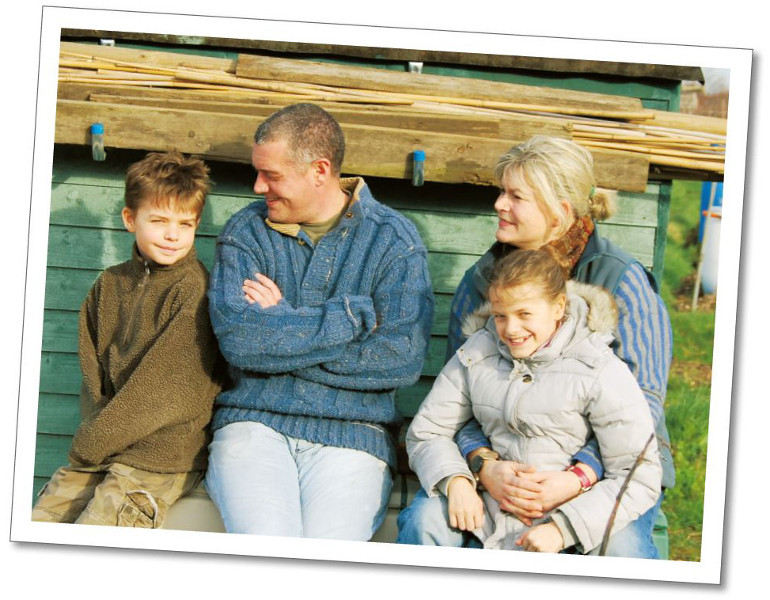
Photograph by Jenny Heller
Chapter 1 | Crop Idle
If the manuscript for this book ever falls into the wrong hands then it may well end up as one of those dreadful reality TV shows: ‘Tonight, on the Obscurity Channel, a new, totally original show which features celebrities living off the land for a year with no supermarket back-up. Who will you vote onto the compost heap of life?’
The frustrating thing is that my children Ellie (10) and Richie (8) would probably have loved watching this show. Unfortunately for them, though, it won’t become a TV programme, which they are just required to watch. It is a family challenge and they are required to live it!

As you might expect, because I’m a professional chef, food is very high up our list of priorities at home. We spend far more money in restaurants than we do on any other form of entertainment and, at home, both my wife Mary Jane (MJ) and I devote a significant amount of time to cooking. Our weekly menus are always home-made with fresh ingredients. Despite all our good intentions, however, there is lots of room for improvement. We, like most people, buy most of our produce from the supermarket. Our children’s culinary quirks have forced seasonality off the agenda; and we have certainly made no contribution to the world of home-grown vegetables. In fact, my kids think soil is just dirt and, therefore, something to avoid. I have begun to realise that it is my job as a father (and a chef) to give my children a sound culinary education.
The children of chefs are no different to any others. When I had children, I naively assumed that the battles over food that my friends had experienced with their children would simply not happen in my home. I thought my kids would somehow be genetically programmed to yearn for stuffed breast of guinea fowl or rare grilled calves’ livers, while utterly rejecting anything in breadcrumbs that requires deep-frying. I was horribly mistaken. Ellie and Richie have both challenged my patience to the limit with their whimsical likes and, more often, dislikes, which are aired regularly at mealtimes. If one of my social duties is to give my children a love of good food, then who masterminded my own education? (Or was I just a natural?!)
The truth is that I was probably not much better. My mum is a great cook and, certainly, my more adventurous cooking is a result of her repertoire, actually the fact that her wacky cookery used to embarrass me as a child. She would never buy anything pre-prepared that required ‘20 minutes at 180 degrees’. Rather, she made everything from scratch. Worse still was the fact that she wouldn’t cook what I considered ‘normal’ food – the kind of stuff my friends were eating, like sausage and mash and burgers. Oh, no, she was busy fluffing up basmati rice or stuffing an aubergine. This simply was not very Surrey circa 1975. Nowadays, of course, this type of food is de rigeur, so I am immensely proud of her efforts and give her full credit for leading the culinary fusion revolution. I don’t often mention the humiliation my sister Ali and I felt when our friends were served up a pork belly curry …
Two other people who had a profound effect on my culinary development were my grandparents, Dick and Marjorie (two solid grandparent names, I feel). They had a lovely cottage surrounded by a large garden, in which my sister and I would spend many happy hours. Grandpa was retired and spent nearly all his time pruning shrubs, nurturing flowers or tending to the wide variety of produce he grew each year. They were entirely self-sufficient when it came to fruit and vegetables and lived strictly by the seasons. I never once knew my granny to buy anything other than the odd bit of exotica from the greengrocer (oranges, bananas or sometimes grapefruit). Otherwise every herb, salad item, soft fruit, apple, walnut, fig and a vast array of vegetables went from Grandpa’s garden down to Grandma’s kitchen. It was here that Granny, a 1930s domestic science teacher, came into her own.
I reckon Marje spent most of her life in her kitchen. She was always pickling or baking or preserving. She knew every trick in the book about utilising a harvest, and I can still taste her simple and very English cooking now when I close my eyes. Looking back as an adult with children of my own, I can appreciate how lucky I was to have known this way of life and, above all, how living by the seasons, with all that one can grow, is the ideal way to live.
I realise that their efforts were not unique. Growing vegetables was an essential part of life in those days. The post-war years were full of memories of food shortages and rationing. People were careful about waste and made the most of the seasons. Ironically, when considering this, rather than looking back and feeling sorry for a generation for whom a pineapple was a major treat, I start to feel envious of a generation who went blackberry picking when they fancied a pudding!
Seasonal eating was not a lifestyle aspiration for my grandparents; it was a natural law that governed what ended up on the dinner table. As I cruise the aisles of our local supermarket happily buying green beans from Kenya and asparagus from Peru, it dawns on me that, despite cooking professionally for 20 years, I have rather missed or forgotten the wider issues concerning food. My obsession with winning a Michelin star had all but cancelled out any thought of food miles, animal welfare, seasonal cookery or the real joy of picking something and then very simply cooking it. I realise that I should worry far more than I ever have done about where my family’s food is coming from and how it is grown.
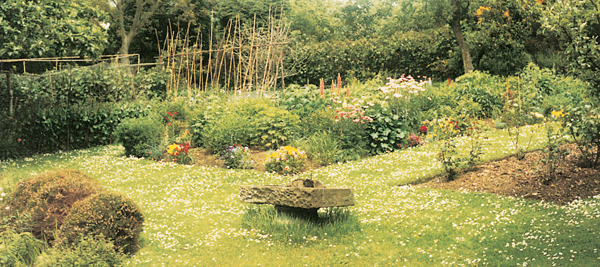

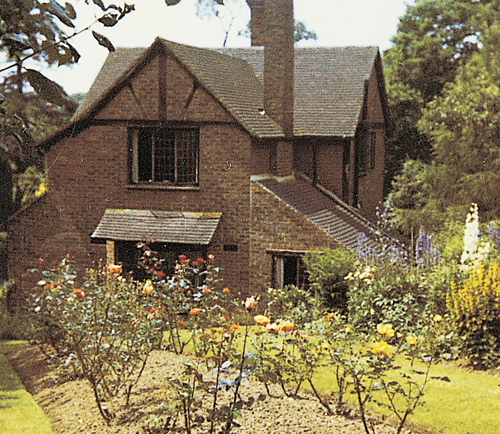
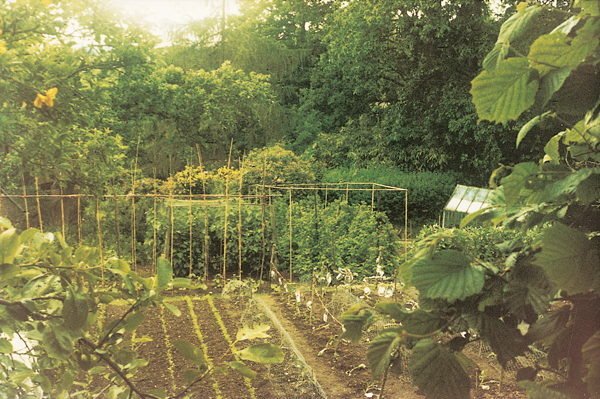
Photograph by Paul Merrett
While acknowledging all this as the right way forwards for our family, I would not dare to suggest that I am at the forefront of change. I have sat at many a dinner party listening to people from all walks of life ‘bang on’ about food miles and globalisation, and my standard response has been to consider them the ‘brown rice and sandals’ types, and to turn the conversation to what I considered more ‘foody’ matters, such as current restaurant trends and the latest cookbooks. There is no doubt, however, that food issues are a hot topic and I have to accept that I have some ground to make up; probably the very reason for my belated conversion is that I have spent so much time in the pampered world of fine dining.
Of course, the easy option would be to buy a few books and feast on a few culinary sound bites. There are many very good books dedicated to all aspects of the great food debate and a quick check of the average politician’s fingernails will probably reveal that their new-found food policy came from a book rather than a muddy field. Well, I want my family’s love of food to be a genuine, muddy, hands-on experience – one that we will remember all our lives.
My own family lives a very busy, urban life. Our small city garden is kept as low maintenance as possible. We have a shed for our bikes, a bit of decking and a few shrubs. It’s a lovely place to sit on a summer’s evening, but we have never considered growing anything that might contribute to a meal. In fact, because of our hectic schedules, the garden is mostly ‘laid to AstroTurf’. Our real lawn had started to resemble the penalty area at Griffin Park, the home of our beloved local football team, Brentford FC, from being used for footy training by Richie and his mates. With a good deal of guilt, we replaced it with shiny plastic grass. It now looks, from a distance, like a putting green at Wentworth, and the best we could do there, food-wise, is a bowl of plastic fruit.
The more I think about it, however, the more convinced I am that my grandparent’s generation enjoyed a relationship with food that I witnessed as a child but have conveniently forgotten as an adult. Having discussed much of this with MJ, and she agreed that we might all benefit from a bit of home-grown produce, and adds that, as a family, we aren’t particularly well placed on the ‘those doing their bit to save the planet’ list. We decide we will not only try to grow our own fruit and vegetables, but also start to live a more ethical existence all round. This meeting of minds is encouraging, particularly as MJ has, up to now, been the sort of person who jumps in the car and drives 300 metres to the nearest shop.
MJ suggests we start by growing a few carrots, tomatoes and beans so that our fussy children can start to understand where their vegetables come from, how natural they are and, thus, why they are so healthy. Great point, I agree, but I indicate our lack of green space. Where will we grow them?
What we need is an allotment. We talk this through and become excited at the prospect of sowing cabbages, plucking apples from our own trees and digging up armfuls of new potatoes, marking each harvest with seasonal eating. An allotment will allow me to recreate those dishes of my childhood as well as to create some new ones of my own.
It will not just be about fancy finished dishes, however. Seasonal cookery will mean dealing with an excess of produce at times, so we will also make the most of preserving, jamming, freezing and batch-cooking our bounty, as my granny did. This way we can enjoy raspberries in December or green beans in January. We will cook our food as it finds us. We are two working parents with all the commitments that go with a busy life but, rather than buy out-of-season, vitamin-deficient vegetables from the supermarket, we shall get a cheap, local allotment and grow the real version ourselves.
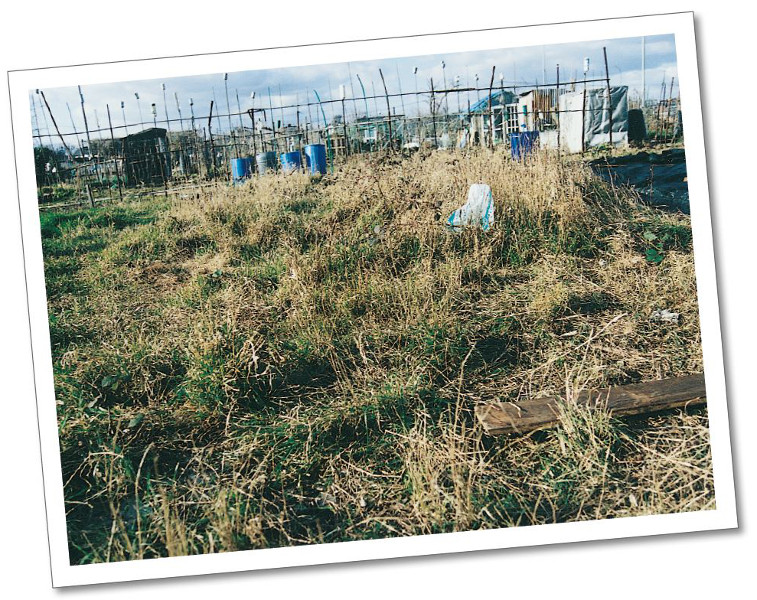
Photograph by Mary-Jane Curtis
Chapter 2 | By Royal Appointment
Anyone who has taken the life-changing decision to get an allotment will know that, in the last ten years, demand for allotments has escalated beyond belief. Gone are the days when allotments were the exclusive domain of old men, in oversized trousers held up with twine, growing vast amounts of root vegetables. Allotments are in demand from all areas of society: very trendy media types, posh people, very poor people, the arty farty set … and old men in oversized trousers held up with twine. They all want a patch of land to call their own. Perhaps, if someone can find a way of making serious money out of allotments, it won’t be long before supermarkets are knocked down and replaced with more plots of land and rickety sheds.
MJ and I both feel that, with an allotment, the kids will enjoy watching things grow and, as a result, will be more adventurous at mealtimes; we will all spend time together with a common purpose; and we can turn our backs on the devil of the day – the supermarket. This will not be because we are doing something amazing, just the opposite. We are a very normal family, with all the normal hassles of life, and we are just trying to get back in touch with one of life’s most enjoyable and important aspects, food.
So, we register online with our local allotment association and soon we receive details of all the local sites. MJ chooses the three nearest ones and we call all three to check availability. Two have nothing available and a waiting list as long as a ball of garden twine, but the third call is rather more hopeful. A few days later we get up early for our first visit to Blondin Allotments.
It’s a wet and chilly Sunday morning in November. Although the allotments are only about half a mile from our house, MJ and Ellie decide to drive down, which I feel is hardly in the spirit of things; Richie and I go on our bikes.
Our appointment is with Keith, who is the Chairman of the Blondin Allotments committee. Keith has got a beard. This makes him look like an outdoor sort of bloke. I am hoping, however, that I can avoid the facial hair and just settle for a pair of wellies.
We are shown our proposed allotment and told to think about it. It costs £27.50 a year and an (optional) extra £5 gives us access to the association’s lock-up shed, where there is a variety of equipment for general use; it also gives us use of the allotments’ snazzy composting toilet.
Along with these benefits, inevitably there come certain obligations and any new plot holder has to agree to the allotment rules. We ask Keith what the rules are and he replies that he doesn’t have them on him. But, in brief, he tells us they are:
1 The gates must be kept locked at all times
2 Garden waste (from one’s home garden) must not be dumped on the communal compost heap
3 A hosepipe can only be used if it is manned – there must be no tying it to a fork handle and nipping home for tea
4 There will be immediate eviction by the committee if one’s plot is not suitably maintained
We are quite comfortable with points one to three – we will be fine locking the gate, we don’t have any garden waste back home and, in a fit of greenness, we have recently given our hosepipe to my sister – but rule four has a sinister ring to it.
MJ asks Keith to what level they expect each plot to be maintained. She points out that we are new to this gardening game and may require a little leniency. Keith, sensing our apprehension, quickly explains that, if any plot is left completely unworked for more than three months, the plot holder receives written notice in the form of an improvement order. Failure to comply leads automatically to eviction. This all sounds a little overbearing to me, but, as MJ points out, with so many people wanting to rent an allotment, it would be wrong to leave a plot in disrepair. And, anyway, this shouldn’t bother us at all because we are so up for the challenge that we can’t imagine a day passing without a quick visit to our allotment.
Keith explains that we will meet many people on the allotments who have been ‘at it’ for twenty years or more so we shouldn’t worry too much. He goes on to tell us that we can expect to find good soil here and that, with dedication and commitment, we will soon be reaping the benefits.
It feels strange to be standing in the middle of a huge field, in which so much produce is growing in the heart of west London. Overhead the planes are lining up to land at Heathrow Airport and, in the distance, I can see cars driving over the M4 flyover. Yet, here we are, in a small part of rural farmland Britain!
The allotments themselves are fascinating: some are beautifully laid out with rows of cabbages, beetroot, onions, potatoes; others appear to be totally neglected. Unfortunately, our plot is in the latter category. It is completely overgrown with brambles and something called cooch (or couch) grass, which I realise I shall have to find out about because Keith seems to feel its effect on growing is only marginally better than a nuclear winter. There is, however, a strip down the centre of our plot that has been cleared and covered with a plastic sheet. Keith tells us this was done the previous year by three Lithuanian students. I am not sure why this small strip among the forest of brambles and weeds was cleared or why the clearers were Lithuanian, but it does seem obvious that the reason we have been offered a plot at all is because it is not a plot at all. It will require serious attention before we start to grow anything. I had assumed that we would be offered a previously cultivated plot which would be ‘good to go’, so this is a bit of a shock. What’s even more of a shock is that MJ doesn’t mind in the least that we are about to accept a jungle of weeds that would be flattered by the term ‘wasteland’. She is chomping at the bit to get digging, which I suppose I should find encouraging.
We agree to let Keith know our decision and he suggests that we look around the whole site to get an idea of what can be achieved. As we walk around we see quite a few people who are already working their plots, despite it being early on a Sunday morning. I reckon there are at least fifteen different nationalities and all age groups represented.
On our way out of the site we meet Sheila who, by all accounts, has one of the best allotments. She is a lovely lady, and she immediately offers us a glass of white wine. As it is only half past nine in the morning and we have not yet had breakfast, however, we decline this generous offer. Sheila is about sixty years old with bleached hair. She is great with our kids, and invites them to look around at what she has grown; she even gamely chuckles as Ellie and Richie pull up most of her carrots and trample through her spinach. In one lovely moment she comes out of her shed and says, ‘Look at my melons’, at which MJ shoots me a glance. Sure enough, however, Sheila has grown melons during the summer, the seeds of which are drying ready for next year. She also has chillies growing, which is a big relief for me as it means we should be able to have spicy food over the next year.



